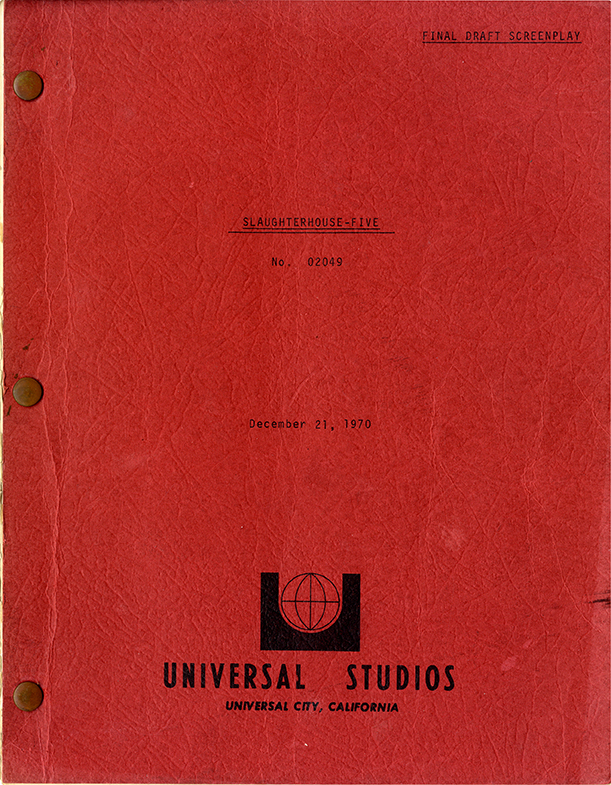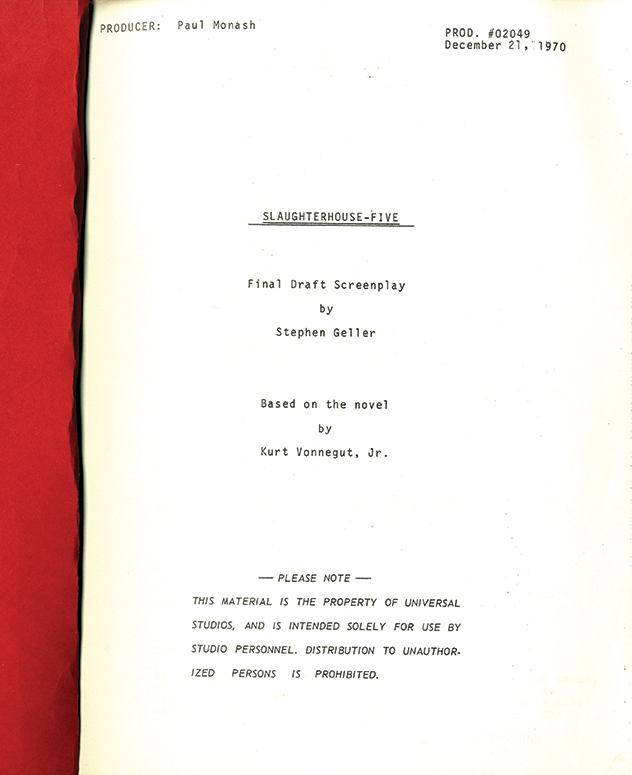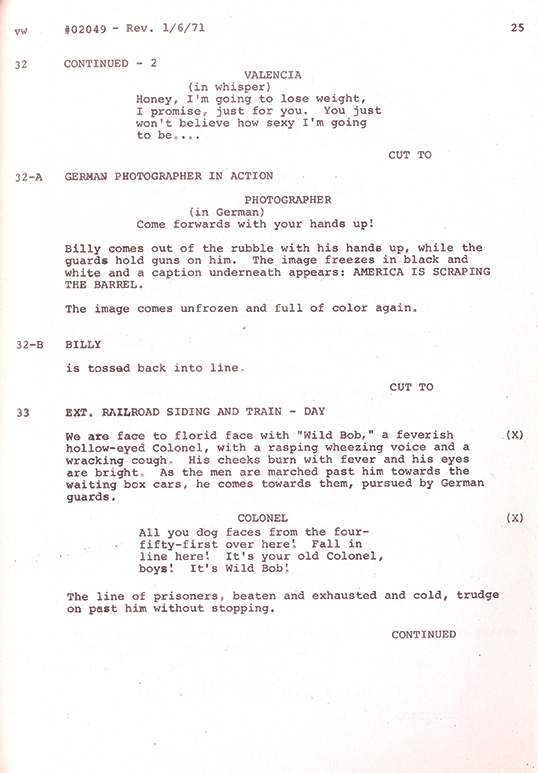SLAUGHTERHOUSE-FIVE (Dec 21, 1970) Final Draft screenplay by Stephen Geller
Kurt Vonnegut (source) Final Draft Screenplay by Stephen Geller Universal City: Universal Studios, December 21, 1970. Vintage original film script, quarto, printed wrappers, brad bound, mimeograph, 134 pp. One page on pink paper dated 12-23-70, minor creasing to covers, near fine in very good+ wrappers. 95 pp.
Slaughterhouse-Five, director George Roy Hill’s film adaptation of Kurt Vonnegut, Jr.’s celebrated novel, was awarded the Jury Prize (Prix du Jury) at the 1972 Cannes Film Festival. Vonnegut himself was greatly pleased with the adaptation:
“I love George Roy Hill and Universal Pictures, who made a flawless translation of my novel Slaughterhouse-Five to the silver screen … I drool and cackle every time I watch that film, because it is so harmonious with what I felt when I wrote the book.“
As well he should have been, insofar as Stephen Geller’s screenplay ranks among the most masterful adaptations of a “difficult” novel ever committed to the screen.
Los Angeles-born screenwriter Stephen Geller, who also wrote the screenplays for The Valachi Papers (1972) and Ashanti (1979), as well as writing and directing Mother’s Little Helpers (2005), was additionally a playwright and a novelist. His first novel, She Let Him Continue, was adapted to the screen as Pretty Poison in 1968.
Kurt Vonnegut’s novel Slaughterhouse-Five presented enormous difficulties to any would-be adapter, due to its mixture of genres and forms. It is a metafictional semi-autobiographical work, based in large part on author Vonnegut’s experiences as a prisoner of war during World War II, and his traumatic first-hand experience of the bombing of Dresden where he was imprisoned. The novel is part fictionalized memoir, part anti-war novel, part satire, part essay and part science fiction. After a brief introduction, the novel, per se, begins like this:
Listen:
Billy Pilgrim has come unstuck in time.
Vonnegut explains further:
“Billy has gone to sleep a senile widower and awakened on his wedding day. He has walked through a door in 1955 and come out another one in 1941. He has gone back through that door to find himself in 1963. He has seen his birth and death many times, he says, and pays random visits to all the events in between.“
Consequently, both the book and the screenplay based on it skip about in time in almost random fashion. The novel and film’s closest cinematic precedents are the time-fractured storylines of D. W. Griffith’s Intolerance (1916) and Orson Welles’ Citizen Kane (1941), along with the time-scrambled meta-narratives of French New Wave director Alain Resnais, notably his 1968 science fiction film Je t’aime, je t’aime, which the movie of Slaughterhouse-Five resembles in multiple respects.
Like Kurt Vonnegut, theater and film director George Roy Hill (1921-2002), was a veteran, having served as a Marine Corps transport pilot in World War II and later recalled to duty as a night fighter pilot in the Korean War. Following World War II, Hill studied James Joyce’s “Ulysses” and “Finnegans Wake” at Trinity College, Dublin — which surely must have influenced his approach to Slaughterhouse-Five. After establishing himself as a Broadway theater director, Hill’s first film directing job was an adaptation of Tennessee Williams’ Period of Adjustment (1962), which he had directed on the stage. His most acclaimed movies, prior to Slaughterhouse-Five, were The World of Henry Orient (1964), the epic Hawaii (1966), and the mega-popular Butch Cassidy and the Sundance Kid (1969). The Sting, his 1973 follow-up to Butch Cassidy, earned Hill the Academy Award for Best Director. Hill’s greatest gift as a director, shown to fullest advantage in Slaughterhouse-Five and The World According to Garp (1982), was his casting and directing of acting ensembles.
Vonnegut’s book is a groundbreaking literary tour-de-force, intentionally rambling and digressive. A case can be made that Geller and Hill’s movie adaptation improves it, giving the story a tighter, more organized narrative structure, and greater depth of characterization.
Most of the changes from novel to film — at least from a screenwriter’s perspective — would have to be considered improvements. For example, Billy’s antagonist, the twisted revenge-obsessed Paul Lazzaro (played by Ron Leibman in the film) is introduced far earlier in the screenplay than he is in the novel. His promise, ultimately fulfilled, to murder Billy (Michael Sacks) is one of the things that gives the story an arc, making it more than a collection of random moments. In the novel, the aliens from Tralfamadore who abduct Billy are described as “two feet high and green and shaped like plumber’s friends”. In the screenplay, they are invisible fourth-dimensional beings — all the better to observe Billy from a perspective outside of time.
The central incident in the book, from which all moments radiate outward, is the tragic firebombing of Dresden. Almost any film as well-executed as this one depicting that incident at length could not help but make the experience more visceral than just reading about it. In the novel, Billy’s best friend, the impeccably decent, middle-aged teacher, Edgar Derby, is executed by the Germans for picking up a teapot from the bombing rubble. In the movie, Derby is executed for picking up a tiny Dresden porcelain figurine that miraculously survived the bombing, a symbol so apt and ironic that Vonnegut should have thought of it himself (though, in Vonnegut’s defense, the book’s description of his friend being shot for picking up a teapot was based on something that actually happened).
Most of the movie’s brilliant editing was pre-planned in the screenplay. For example, on page 3 alone, we cut from Billy at his typewriter in upstate New York in 1971, to Billy under a geodesic dome with his starlet paramour, Montana Wildhack, on the planet Tralfamadore sometime in the future, to Billy on a Belgian battlefield in 1944, and back again to upstate New York. Many of the cuts indicated in the screenplay are based on visual/thematic associations, as when a shot of a soldier’s boots in 1944 cuts to a shot of Billy’s shoes on his honeymoon in 1947. Sound editing cuts are also indicated in the screenplay as in the montage sequence described above where the sound of Billy typing cuts to the sound of a machine gun firing on the battlefield.
Differences between the screenplay and the completed film are minor, mainly some trimming of the dialogue. Other scenes are elaborated upon in the film’s staging as when Billy, dressed like a scarecrow, and the other captured Americans first enter Dresden. In the film (but not in the screenplay) he is joined by local children who march along with him as though he were a clown in a parade.
While the screenplay and movie are scrupulously faithful to the events and language of Vonnegut’s book, the book’s characters and dramatic situations required fleshing out. As Vonnegut himself notes at one point in the novel:
“There are almost no characters in this story, and almost no dramatic confrontations, because most of the people in it are so sick and so much the listless playthings of enormous forces.“
Thus, the novel’s personae, some of them hardly more than abstractions — like the old German commandant, Billy’s overweight wife Valencia, and even Billy’s dog Spot — become fully realized characters in Geller’s screenplay and Hill’s film. And their fates, described with ironic detachment in Vonnegut’s book, become unexpectedly moving when played out on the screen.
Numerous good or great movies have been made from books that were of average or worse quality (think Vertigo or Touch of Evil), but rarely does an arguably great work of literature become an even better film. Orson Welles’ The Magnificent Ambersons may be one example, and so, arguably, is Stephen Geller’s and George Roy Hill’s adaptation of Slaughterhouse-Five.
Out of stock
Related products
-
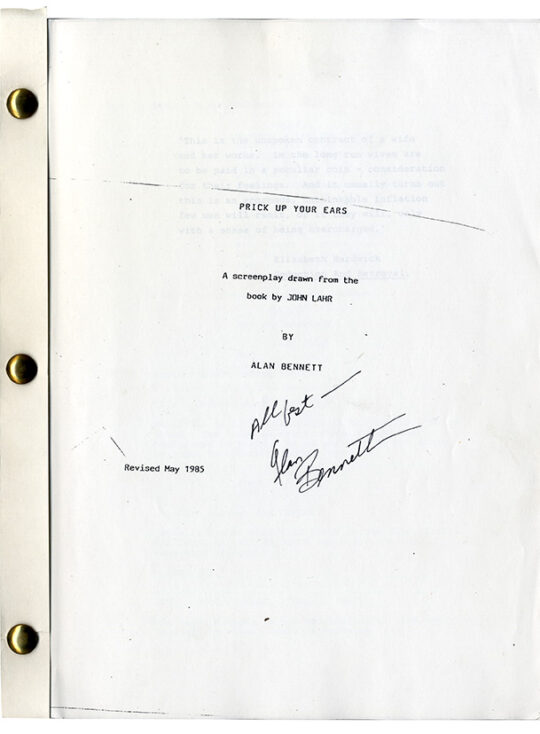
PRICK UP YOUR EARS (May 1985) Revised film script
$650.00 Add to cart -
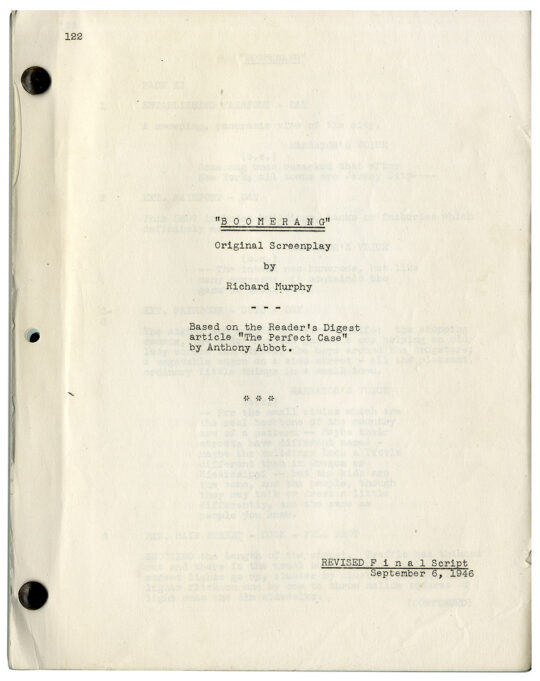
(Film noir) BOOMERANG (1946) Revised film script by Richard Murphy
$850.00 Add to cart -
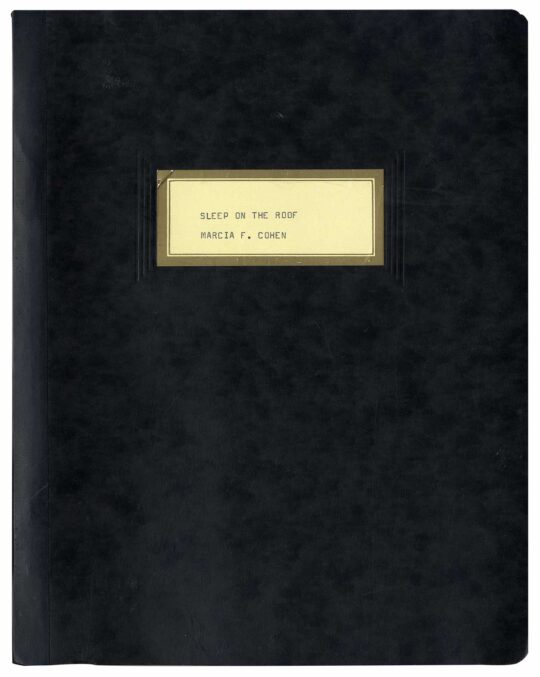
SLEEP ON THE ROOF (1967) Unproduced script based on the life of Margaret Sanger
$500.00 Add to cart -
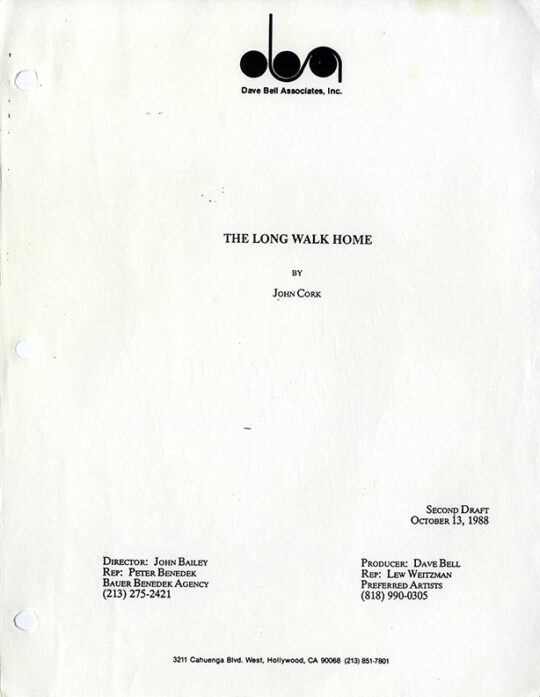
LONG WALK HOME, THE (Oct 13, 1988) Second draft film script by John Cork
$375.00 Add to cart

